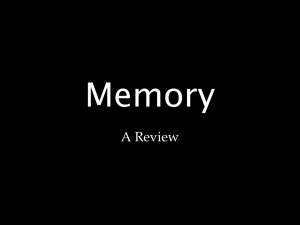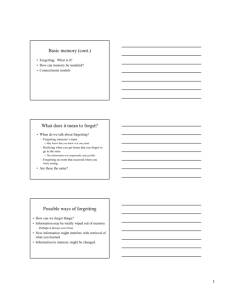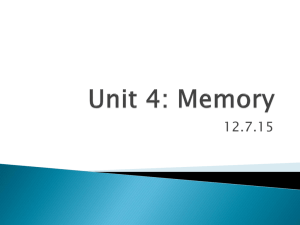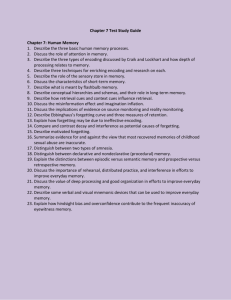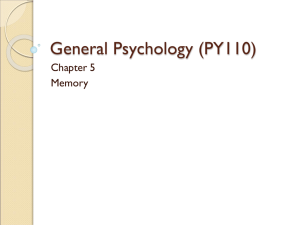REMEMBERING: THE ROLE OF THE CUE Remembering as “ecphory” Cue Specificity
advertisement
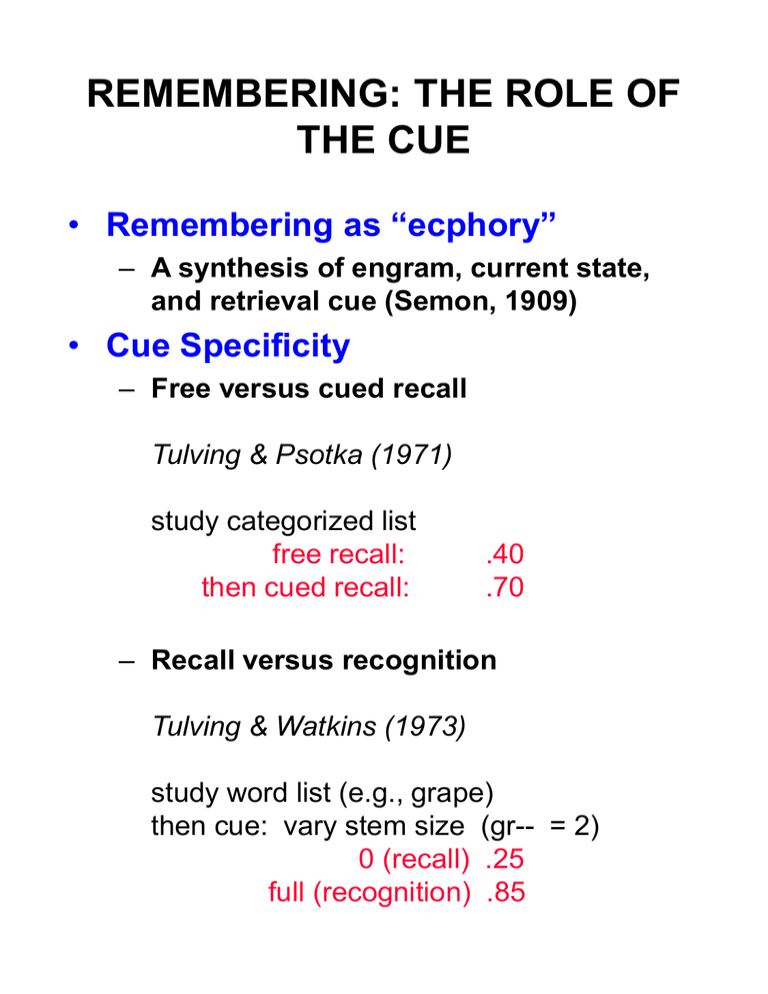
REMEMBERING: THE ROLE OF THE CUE • Remembering as “ecphory” – A synthesis of engram, current state, and retrieval cue (Semon, 1909) • Cue Specificity – Free versus cued recall Tulving & Psotka (1971) study categorized list free recall: then cued recall: .40 .70 – Recall versus recognition Tulving & Watkins (1973) study word list (e.g., grape) then cue: vary stem size (gr-- = 2) 0 (recall) .25 full (recognition) .85 • Encoding/Retrieval Specificity (Tulving, 1973) – Compares E/R Match versus Mismatch – Small but reliable effects of: • • • • Verbal/associative “context” Encoding task and level Physical environment Internal state and mood – Larger effects when other cues weak Eich (1975): Marijuana / Placebo Study categorized list of 48 words Study Pla Pla Mar Mar Test Pla Mar Pla Mar Free Recall 11.5 9.9 6.7 10.5 Cued Recall 24.0 23.7 22.6 22.3 • E/R Specifity (cont’d) – Larger effects with “contextual encoding” Eich (1985): study / test room match / mismatch study long word list imagery instructions: isolated integrate with environment Probability of Recall 0.5 0.4 0.3 0.2 0.1 0 integrated isolated Imagery instructions E/R Match E/R Mismatch CUE-DEPENDENT FORGETTING • Occlusion – Cue activates other memories – Watkins’ (1979) cue overload principle – The “fan effect” – Classic associative interference Retroactive Interference Design RI A-B control A-B A-C rest A-B A-B Proactice Interference Design PI A-C Control rest A-B A-B A-B A-B ASSOCIATIVE INTERFERENCE AND FORGETTING task: study and remember lists of paired-associates (A-B) B A C learning AC interferes with AB AB learned first: Retroactive (RI) AC learned first: Proactive (PI) RETROACTIVE INTERFERENCE IN PAIRED-ASSOCIATE MEMORY (Barnes & Underwood, 1959) C u e d R e c a ll ( % ) task: study and remember lists of paired-associates 10 Trials of AB pairs then 1 to 20 trials of AC pairs 100 80 60 "C" recall 40 "B" recall 20 0 0 5 10 15 20 # Trials on AC Lists is AB association erased (“unlearned”)? NO: recognition-matching still good • Occlusion (cont’d) – Part-list cuing effects (Roediger, 1973) categorized lists, seven instances cue with: category name only and one instance and two instances and five instances pc(remaining) .63 .62 .56 .52 – Output interference • Recall of items within a category reduces PC of remaining items – (Smith 1971): categorized lists - controls order of category cues - recall decreases across order • Occlusion (cont’d) – Retrieval-induced forgetting (Anderson, Bjork & Bjork, 1994) Study sets of category-instance pairs FRUIT - orange; FRUIT - apple, etc TOOL - drilll; TOOL - hammer, etc Retrieval practice on half of some categories: FRUIT – or_____ Cued recall test of all pairs: FRUIT - ? “good” e.g.’s “weak” e.g.’s RP+ .81 .66 RP.41 .35 No RP .56 .41 – Gargano & Chandler (1999): less interference with “study” practice only – Veling & van Kippenberg (2004): recognition speed for target words RP+: 678 ms RP-: 810 ms NRP: 759 ms CUE-DEPENDENT FORGETTING (CONT’D) • Suppression – Target is inhibited, becomes less accessible to other cues “cross-cue” forgetting observed in some studies: Anderson & Spellman, 1995: practiced within-categ RED-blood .74 unpracticed within RED-tomato .22 unpracticed across, related FOOD-strawberry .22 unpracticed across, unrelated TOOL-drill .38 • Suppression (cont’d) – But some failures too: Gargano & Chandler (1999) Type of Cue during… practice test RP- No RP FRUIT-or___ FRUIT-or___ .71 .79 FRUIT-__nge FRUIT-or___ .78 .80 Fischler & Woods (1985): train AB, DB associates RI with half of A stimuli: AC pairs strong forgetting of A – B no forgetting of D - B IS MEMORY PERMANENT? • The arguments for and against – Some memories seem to “last a lifetime” – But they may not; and others don’t – Much of forgetting seems to be “retrieval failure” – But sometimes all cues fail – Brain stimulation seems to awaken specific memories (Penfield, 1952) – But the effect is rare (40 of 520 patients), and events seem more schematic than episodic – Interference in the lab dominates forgetting – But the “forgetting function” is beautifully time-dependent (Power Law) – No confirmed mechanism of “decay” at neural level – But some evidence, and a long way to go
